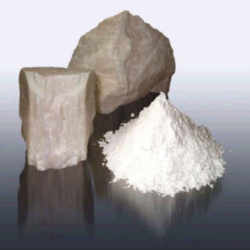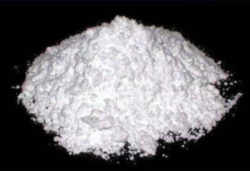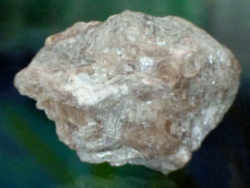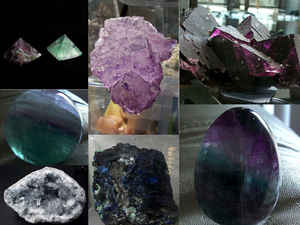
Vermont Symbols
Vermont State Mineral
Talc
Hydrous magnesium silicate
Mg3Si4O10(OH)2
Adopted in 1991.
The Vermont State Mineral is Talc, Silicate mineral adopted in 1991. Talc, the State Mineral, is metamorphic in origin, formed in thin slivers of ocean crust left here after the continents collided. Generally found in southwestern Vermont, it is green in color and very soft. In 1990, Vermont ranked second only to California among the states which produce talc. Ground talc is used in plastics, paper, rubber and paint.
Grossular garnet, the State Gem, is technically a mineral - a silicate, which is colored brown due to the presence of iron. Grossular garnet from the Belvidere Mine at Eden Mills is thought to be the finest specimen of its kind anywhere.
------- from Office of the Secretary of State, Vermont Legislative Directory and State Manual, Biennial Session, 1993-1994, p. 25.
Vermont State Miner: Talc
 Talc, Vermont State Mineral, is metamorphic in origin, formed in thin slivers of ocean crust left here after the continents collided. Generally found in southwestern Vermont, it is green in color and very soft. In 1990, Vermont ranked second only to California among the states which produce talc. Ground talc is used in plastics, paper, rubber and paint.
Talc, Vermont State Mineral, is metamorphic in origin, formed in thin slivers of ocean crust left here after the continents collided. Generally found in southwestern Vermont, it is green in color and very soft. In 1990, Vermont ranked second only to California among the states which produce talc. Ground talc is used in plastics, paper, rubber and paint.
Metamorphic in origin, formed in thin slivers of ocean crust left here after the continents collided. Generally found in southwestern Vermont, it is green in color and very soft. In 1990, Vermont ranked second only to California among the states which produce talc. Ground talc is used in plastics, paper, rubber and paint It is also used to coat products which need to slide apart easily, such as nested stacks of plastic pails in a hardware store! Soapstone, composed of chlorite and talc, can withstand intense heat and is used by some companies to make countertops and sinks. The Green Mountains are comprised of folded and faulted metasedimentary rocks, metamorphosed volcanic rocks and slivers of ocean crust (serpentinized ultramafic rocks). Talc, soapstone, and verde antique are associated with the ultramafic rocks. Talc is currently mined in the Ludlow area.
PHYSICAL CHARACTERISTICS OF TALC:
 Talc is one of the common minerals in metamorphic rock. Although talc deposits can be found throughout the world in various geological contexts, economically viable concentrations of talc are not that common.Abundant mostly on east side of Green mountains, near talcose slate, and found in a belt whole length of State. Marlborough, Windham county, known as "chalkstone;" Newfane, Chester, Grafton, and Athens, large quarries; also in Bridgewater, Plymouth, Cavendish, Weathersfield, Bethel, and Rochester, Windsor county; thence north in Washington, Lomoille, Franklin, and Orleans counties.
Talc is one of the common minerals in metamorphic rock. Although talc deposits can be found throughout the world in various geological contexts, economically viable concentrations of talc are not that common.Abundant mostly on east side of Green mountains, near talcose slate, and found in a belt whole length of State. Marlborough, Windham county, known as "chalkstone;" Newfane, Chester, Grafton, and Athens, large quarries; also in Bridgewater, Plymouth, Cavendish, Weathersfield, Bethel, and Rochester, Windsor county; thence north in Washington, Lomoille, Franklin, and Orleans counties.
How talc deposits are formed
Talc deposits result from the transformation of existing rocks under the effect of hydro-thermal fluids carrying one or several of the components needed to form the mineral (MgO, SiO2, CO2). Tectonics play a major role in the genesis of a talc deposit. It enables hydro-thermal fluids to penetrate the rock, creating a micro-permeability that facilitates reactions in the mass. The size and shape of talc deposits depend upon the intensity of the hydrothermal activity which corresponds to the climate of a low temperature metamorphism. Pressure and deformations, both concurrent with and subsequent to this transformation, determine the crystallinity of the talc ore in the deposit.
Types of talc deposit
Talc deposits differ according to the parent rock from which they are derived. Four main categories exist.
- Color is green, gray and white to almost silver.
- Luster is dull to pearly or greasy.
- Transparency crystals are translucent and masses are opaque.
- Crystal System is monoclinic; 2/m.
- Crystal Habits: never in large individual crystals, but if found are flattened tabular crystals with a hexagonal cross-section, usually talc is found in compact or lamellar masses. Forms pseudomorphs (false shape) of other crystals such as quartz, pyroxenes, olivine and amphiboles.
- Cleavage is perfect in one direction, basal.
- Fracture is uneven to lamellar.
- Hardness is 1 (can leave mark on paper)
- Specific Gravity is 2.7 - 2.8 (average)
- Streak is white.
- Other Characteristics: cleavage flakes are slightly flexible but not elastic and talc has a soapy feel to the touch.
- Associated Minerals include serpentine, dolomite, magnesite, quartz, pyroxenes, olivine, biotite and amphiboles.
- Notable Occurances: include many mines up and down the Appalachian Mountains and in California and Texas, USA; Germany; Florence, Italy; Tyrol, Austria; Transvaal, South Africa and Shetland, Scotland.
- Best Field Indicators softness, color, soapy feel, luster and cleavage.
Vermont Law
Vermont Statutes Annotated, Title 1, Chapter 11, Section 508.
TITLE ONE. GENERAL PROVISIONS
CHAPTER 11. FLAG, INSIGNIA, SEAL, ETC.
1 V.S.A. § 508 (2012
§ 508. State mineral
The state mineral shall be talc.
HISTORY: Added 1991, No. 221 (Adj. Sess.), § 3, eff. May 28, 1992.
From Office of the Secretary of State, Vermont Legislative Directory and State Manual, Biennial Session, 1993-1994, p. 25.
Minerals, & Gems

Gemstone, Minerals, Rocks






